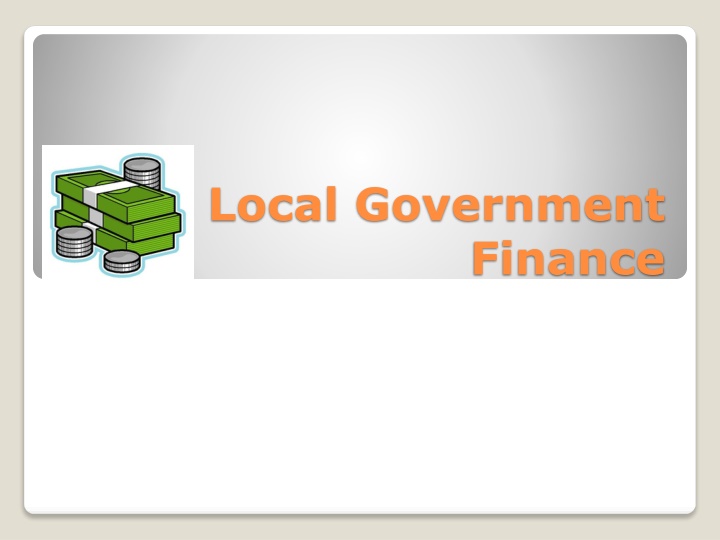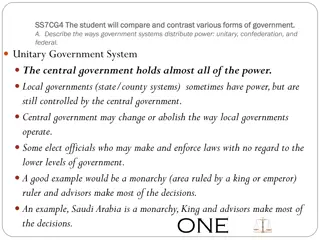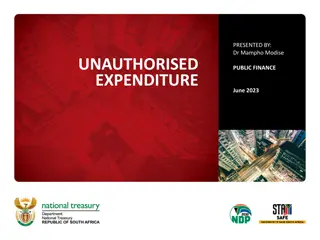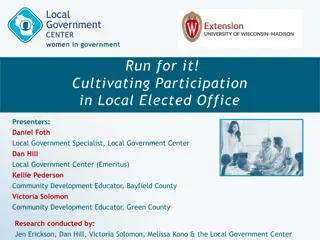Local Government Finance
Local government finance in Scotland is undergoing changes with a focus on austerity. The key areas to comprehend include revenue and capital expenditure, budgeting, service planning, financial reporting, and public accountability. Revenue expenditure encompasses annual service costs, while income is crucial for covering these expenses. Grants from the Scottish Government play a significant role in funding local authorities, along with council tax and fees. Specific grants are provided for targeted purposes, influencing how funds are allocated. Non-domestic rates contribute to local government income through property taxes.
Download Presentation

Please find below an Image/Link to download the presentation.
The content on the website is provided AS IS for your information and personal use only. It may not be sold, licensed, or shared on other websites without obtaining consent from the author.If you encounter any issues during the download, it is possible that the publisher has removed the file from their server.
You are allowed to download the files provided on this website for personal or commercial use, subject to the condition that they are used lawfully. All files are the property of their respective owners.
The content on the website is provided AS IS for your information and personal use only. It may not be sold, licensed, or shared on other websites without obtaining consent from the author.
E N D
Presentation Transcript
Local Government Finance
Introduction Local Government Finance is an area constantly changing which in the medium term will be dominated by a period of austerity for all Scottish public services. There are 8 practical areas to begin to understanding local government finance: Revenue Expenditure & Income Capital Expenditure & Income Revenue Budgeting & Service Planning Capital Budgeting & Service Planning
Relationship between Revenue & Capital Expenditure Managing the Budget Financial Reporting Public Accountability
Revenue Expenditure & Income Revenue expenditure can generally be defined as expenditure which is incurred on the annual costs of service delivery. The benefit derived from revenue expenditure is received within a single financial year. A typical example of revenue expenditure is employee costs. Local Authorities incur annual revenue expenditure of the order of 13b on revenue services. This represents 2.5k per head of the population of Scotland. Revenue expenditure on local authority services, with the exception of council housing, is accounted for through a statutory account called the General Fund Account (GFA) Housing is separately accounted for in a Housing Revenue Account (HRA)
To enable a local authority to incur expenditure, that expenditure must be met by monies received by a local authority, properly referred to as income. The general fund income of a local authority (i.e. the non housing sources of income) will be derived from the following principal sources: - Scottish Government Grant (Including non-domestic rate income) - Council Tax - Fees and Charges for services delivered Scottish Government Grant The budget process of the Scottish Government results in the determination of the local government finance settlement which sets out how much the government is prepared to fund. Grant in the form of total revenue support comprises specific grant, non-domestic rates income and revenue support grant
Specific Grant Local authorities receive grants which are for a specific named purpose, or which are intended to achieve a specific policy objective. Specific grants effectively ring fence monies for purposes as directed by the Scottish Government. This may result in higher administration costs associated with separately accounting for this expenditure and can limit a local authority s ability to integrate these outcomes within its key objectives. Non-Domestic Rates (or Business Rates) is a property based tax which is billed to local businesses and collected by local authorities.
Council Tax The level of Council Tax is determined by each local authority and the authority is responsible for its billing and collection. The level of council tax is set as part of each local authority s budget setting process. In recent years each local authority in Scotland has agreed to freeze the level of council tax at 2008/9 levels. The cost of the freeze is funded by the Scottish Government.
A local authority will already have calculated the number of Band D equivalent houses. An allowance is then made for non-recovery of debt. The final stage is to divide the amount to be raised from Council Tax by the adjusted number of Band D equivalent houses to get the Band D council Tax level. After setting the tax for Band D, the tax for other bands is calculated using the statutorily set equivalent factors.
Valuation Band Band D Equivalent Factor A 6/9 B 7/9 C 8/9 D 9/9 E 11/9 F 13/9 G 15/9 H 18/9
Fees and Charges Local authorities are entitled to charge service users for the provision of certain services they provide. This may be in the form or discretionary or mandatory fees. Discretionary Charges are those which the local authority could provide free of charge. In this case the local authority would used their discretion to levy a charge i.e. charge for use of school premises. Mandatory Charges are those which the local authority must charge for and in a number of instances, the level of charges applied are set by the Scottish Government. Each local authority must be cautious when making assumptions about the likely levels of demand as responsibility for collecting the income will rest with them.
Local Authority Housing Rents Rents are levied on tenants who occupy local authority houses. The income is credited to the Housing Revenue Account (HRA) Housing & Council Tax Benefit Subsidy Local authorities may pay a means tested benefit to tenants and to council tax payers. The benefit is intended to provide assistance in meeting the cost of rent and council tax. The local authority can recovered most of the cost of the benefit in the form of a subsidy, from the Department of Work and Pensions (DWP)
CAPITAL EXPENDITURE & INCOME Capital Expenditure is council expenditure on items which have a useful economic life greater than one financial year. A typical example of capital expenditure is the construction of new council offices. The principal sources of financial capital expenditure are: Borrowing by Local Authorities Using Money From the Sale of Assets Revenue Funds Capital Grants Leasing Including Private Finance Initiative (PFI) Contributions from Other Public or Private Sector Bodies
Borrowing The Local Government in Scotland Act 2003 introduced a new freedom for local authorities which specified that it was the responsibility of each local authority to determine how much it can afford to spend on capital based on affordability, prudence and sustainability. This replaced previous capital controls which were wholly influenced by central direction from Scottish Government. Local authorities determine their own programme for capital investment and in doing so, now determine their own borrowing level, adhering to a professional code developed by CIPFA The Prudential code for Capital Finance in Local Authorities. This code ensures that capital expenditure plans are affordable; external borrowing and other long term liabilities are within prudent and sustainable levels; and treasury management decisions are taken in accordance with professional good practice. The Chief Finance Officer is responsible for ensuring that all matters required to be taken into account are reported to the decision making body for consideration and for establishing procedures to monitor performance.
Using Money from the Sale of Assets Money from the sale of assets is called capital receipts. The money will derive from existing assets which are surplus to requirements and have been sold. The sale results in a cash receipt which can be used to fund future capital investment, thereby reducing the requirement for borrowing. Use of Revenue Funds Local authorities can utilise revenue funding to finance capital expenditure. This is referred to as Capital Financed from Current Revenue or CFCR. Revenue funding from the revenue account is transferred to the capital account. Importantly, the use of CFCR is a funding mechanism to finance capital expenditure rather than the ability to charge capital expenditure to revenue resources. Capital Grants Local authorities may finance capital expenditure from grants, examples of which include: National Lottery; Local Enterprise Companies: and European Regional Development Fund (ERDF). Capital grants can reduce the requirement for borrowing to fund capital investment.
Relationship between Revenue and Capital Expenditure Revenue and capital expenditure are accounted for separately. However, there is a clear relationship between these two types of expenditure. The cost of constructing a building will represent capital expenditure for a local authority. There are however revenue consequences. In addition, the costs of financing the construction of the building are charged as revenue expenditure over a period. Depreciation is the cost of the economic benefit of fixed assets consumed during a financial year and this is treated as revenue expenditure. Depreciation is not however taken into account when the annual budget is set.
Revenue Budgeting and Service Planning The annual budget is the financial expression of the policies of a local authority. Budget preparation is one of the most extensive and visible products of the financial management system of a local authority. It should demonstrate the decisions which have been taken regarding service priorities and the allocation of resources and will be the financial link to the Single Outcome Agreement (SOA) On the basis that significant policy initiatives generally require more than one year to implement, it is important to plan over a longer timescale sometimes up to ten years ahead for the likely effects of demographic changes or economic change, and the medium term consequence of legislative change. Setting a budget is a legal requirement. It is a responsibility of the Chief Financial Officer to ensure that a budget is produced which estimated future expenditure is met by estimated future income i.e. a balanced budget. The statutory requirement is contained within s108(2) of the Local Government (Scotland) Act 1973 and s93(3) of the Local Government Finance Act 1992. Local Authorities are legally required to set an annual council tax level by 11 March of each calendar year
Leasing Including Private Finance Initiative/Public Private Partnership There are 2 recognised types of lease: Operating Lease the substance of this type of transaction will be that the local authority (the lessee) will not won the asset at any time during the agreement. The local authority will treat the cost of the lease as a revenue item of expenditure Finance Lease the characteristics will be similar to that of ownership and the gross amount will be recorded as an asset of the local authority and therefore treated as a capital item of expenditure Private Finance Initiative and public private partnership are arrangements where a local authority can purchase a service, usually a capital intensive service, from a private sector provider over the period of a long term contract. Payments for the service are made, as and when the local authority receives the service, and will vary depending on the private sector provider s performance. The contractor takes responsibility for investing in the capital assets required, financing that investment and then managing the facilities to provide the specified level of service to the authority. A critical feature of this arrangement is that the private sector provided takes the business risk entailed in the commitment to supply the service for the contracted level of payment at an agreed performance standard. Contributions from Other Public or Private Sector Bodies A further source of income may be where there is partnership working between public and/or private bodies. In such cases capital projects may be funded by contributions from partnership or stakeholder bodies.
Service and Financial Planning The budget and service plan process will usually begin with the local authority setting out its key priorities, aims and outcomes. These may be stated in Corporate and Strategic Plans and in the Single Outcome Agreement. Having a clear organisational purpose and set of objectives is a hallmark of good governance. Each service department will be required to consider its contribution to the achievement of these key priorities and this will be expressed in the department s service and financial plan. Good practice suggests that there should be an integration of budgeting with service planning. A service plan which does not demonstrate how the service supports the council s outcomes and priorities and how it will use its total resources finance, property and people to do so will be less robust in practice than once which does. Equally a robust service plan will also contain relevant performance information indicating both the past performance trends of the service in supporting the council s key outcomes and priorities but also indicating how performance will continue to be tracked and reported in the future. Local authorities are expected to have systematically assessed the services delivered and challenge that service deliver to consider the use of resources and whether service reconfiguration is appropriate. There should be therefore a firm link between the budget process and plans for service delivery as expressed in the Single Outcome Agreement.
Preparing the Budget The use of the current year s budget is known as incremental budgeting. If using incremental budgeting local authorities require the following to be addressed: Non-recurring items items of expenditure (or income) which apply only to the current year and will not be required to be budgeted for in the forthcoming financial year; Full year effect Where items of expenditure (or income) impacted upon part of the current financial year only but require to be assessed as applying for the full financial year; and Variances Material or recurring variances which should be fed into compilation of future budgets. Alternatively, zero-based budgeting (effectively starting from zero and compiling the financial figures for each year from origin) can be used. A Key feature of this approach is that existing policies and service levels are not taken for granted, rather the are objectively re-examined. This method demands greater input from officers and elected members into the budget process due to the complexities and time commitments. If it is not practical to use this method for the entire budget, it may be applied to some elements of it.
It is necessary to add new commitments and to deduct known reductions or savings from the base budget. A commitment is generally when there is a contractual obligation or a committee approval for an activity to proceed. Commitments could include the full year effect of previous policy decisions not wholly included in the previous budget (e.g. additional costs where new buildings were opened during the course of the previous year or savings arising where buildings were closed down part-way through a year) The annual pay awards to staff will require to be estimated and the level of annual salary increments accounted for. Changes in prices or charges will also require to be estimated. A typical example may be an estimate for the level of national insurance contributions. There are consequences of undertaking capital expenditure. The purchase of equipment may result in a requirement for a maintenance agreement to be entered into. This would be a running cost and therefore is a revenue cost and should be budgeted for accordingly.
Direct services, such as Education, also require back up of a number of other support services including finance, IT and Governance/Law. The estimated costs of which are included as a recharge to each user department. In addition, a number of major policy decisions may require to be made on the financing of the local authority as a hole. These are over and above the consideration of detailed estimates by departments. Decisions may be required on the use of CFCR or on the use of reserves. In Scotland, local authorities have specific statutory powers to hold reserves. The reserves for which statutory powers exist are: General Fund; Repairs and Renewals Reserve; Insurance fund; and Capital Fund
A reserve will be held to enable a local authority to do 3 things: Create a working balance to help cushion the impact of uneven cash flows and avoid unnecessary temporary borrowing this forms part of the general reserves; Create a contingency to cushion the impact of unexpected events or emergencies this also forms part of the general reserves; and Creates a means of building up funds, often referred to as earmarked reserves, to meet known or predicted liabilities. There is no professional or legislative prescription about the level of reserves which a local authority should hold. The Chief Financial Officer will make a recommendation of the level which will be based on their detained knowledge and professional judgement.
The budget timetable typically commences in the summer months with the Chief Financial Officer seeking information to allow her to aggregate the departmental estimates and to: test the underlying assumptions of their compilation; Ensure that the principles laid down have been followed; and Check the arithmetical accuracy of the returned financial data. Following this, during Autumn moths there are a number of reports being submitted to service committees for scrutiny of elected members and reports by the Chief Financial Officer on trends and the possible effects on services and on local tax levels of changes to the spending levels. December brings the notification of the total revenue support from the Scottish Government which generally prompts further rounds of decision and reporting. February and March bring the final stages in the budget process when the challenge is to get a budget agreed and approved which is balanced i.e. income and expenditure match and that the rate of local tax required to fund the expenditure is accepted.
Capital Budgeting and Service Planning Local authorities invariably prepare plans for spending on capital projects covering 3 or more years. These plans indicate planned spending on individual schemes each year. Capital planning requires to extend over a number of years because of the time taken to initiate and complete schemes, particularly large construction schemes. The budget timetable for capital budgeting generally requires capital plans to be prepared annually between October and December and are submitted for approval, along with the Prudential Indicators, at the same time as the revenue budget. Capital plans must be based upon a firm foundation of asset management planning and supported by option appraisal. The driver for investment should come through service planning processes.
Capital plans will show separately legal requirements which arising from the current year programme either because they are schemes which straddle financial years and approval is already given or because of genuine delays in progress within the current year, the expenditure slips into next year. Potential new schemes will be identified by members/officers as part of the service planning process and selected according to agreed criteria. Criterion will be weighed according to priority e.g. Political priority or required by legislation. Estimates of capital expenditure should include the costs of design and supervision. These estimates need to be totalled across all schemes for each year of the programme in order to draw comparisons with the levels of internal design and supervisory capacity to the authority. Estimates should also take account of design and supervision required in respect of repairs and maintenance works included in the revenue budget. If there are shortfalls in internal capacity, these are generally met through the use of consultants or the employment of additional staff.
When land is required for a capital scheme and it is not owned by the authority, issues such as site selection, planning permission and acquisition by Compulsory Purchase Order (CPO) arise. These issues will have a critical impact on the progress of a capital project and the timescale for dealing with them will be necessarily uncertain. The capital budget should include costs associated with: Acquiring, reclaiming, enhancing or laying out of land Acquiring, constructing, preparing, replacing or enhancing roads and buildings; and Acquiring, installing, or replacing plant, machinery or vehicles The revenue consequences of capital projects can be grouped into 3 categories: - Running costs; - Costs of borrowing; and - Depreciation
Control Mechanism for Revenue Expenditure Despite a former Control Mechanism of Revenue Expenditure being limited by government, this is no longer the case and there are no explicit guidelines set out by the Scottish Government for local authority spending. However, Scottish Ministers have retained powers to cap or re-introduce guidelines. Control Mechanism for Capital Expenditure Section 35 and 36 of the Local Government in Scotland Act 2003 determined that it was the responsibility of each local authority to determine how much it can afford to spend on capital based on affordability, prudence and sustainability. This means that the system is on of self-regulation by local authorities requiring computation and approval of prudential indicators and a heightened role for the Chief Financial Officer. At a national level, Section 36 of the Act provides a power to enable Scottish Ministers to impose national limits on capital expenditure if investment by local authorities is deemed to be excessive. Capital expenditure is largely funded by external borrowing, the control for which is a limitation on the type of debt products which a local authority can use.
Managing the Budget Once a local authority has agreed its service and financial plans, it must then monitor progress in delivery of the planned priorities within the available resource. An integrated approach to monitoring progress should also be encouraged across departments. It is therefore important that a suite of Performance Indicators exist to monitor the level and efficiency of service delivery throughout the year. These indicators are likely to include Statutory Performance Indicators supplemented by a range of key performance indicators. The frequency of monitoring may vary depending on the nature of the indicator.
Role of Elected Members Members must ensure that proper control is exercised on the authority s expenditure through the scrutiny of regular financial reports comparing expenditure with budget provision. The actual frequency at which financial monitoring statements will be considered by elected members will be determined by the governance arrangements of each local authority. However, the more frequent the scrutiny the more likely that any adverse variances will be highlighted enabling corrective action to be taken. The process of budget monitoring and control involves the following steps:
Comparison of actual expenditure against budgeted spend (as a whole, at individual service level or for specific areas such as council tax collection) Comparison between what has actually happened to date (within the current year or previous years) with the assumptions made in the budget can give an indication of whether current conditions are moving away from the assumptions made in the budget. Forecasting where the year end view is compared to budget to determine whether there is likely to be a variance, either positive or negative. Commitments made by the local authority by committing future resources Profiling Predicting he pattern of expenditure (or income). Variance the difference between actual and budgeted expenditure (or income for one period, for the cumulative actual position to date, or the difference between the full year forecast and full year budget. Budget managers must identify and analyse material variances i.e. those variances above a certain level. Any variance should be the subject of immediate transparent reporting. A recurring problem identified within the current financial year as this may have implications for future budgets.
Financial Reporting Under the Local Government (Scotland) Act 1973, each local authority is required to prepare financial statements (referred to as the Abstract of Accounts) for approval by the election members prior to 30thJune each year. The production of the financial statements is the responsibility of the Chief Financial Officer and summarises the actual financial performance of a local authority between the period from April to March. They are based on accounting practices recommended by the Local Authority (Scotland) Accounts Advisory Committee (LASAAC)
LASAAC discharged their responsibility by their annual approval of an Accounting Code of Practice produced for the UK by CIPFA and LASAAC and which is applicable to all local authorities. The financial statements include an income and expenditure account which provides a summary of the revenue expenditure and income of the local authority s general fund for the financial year, a balance sheet which represents the position of the local authority with all outside parties at the 31stMarch and shows the assets fo the council, a cash flow statement and group accounts. The Local Authority (Scotland) Amendment Regulations 1997 require local authorities to submit the financial statements to the Accounts Commission by 30thJune. Significant Trading Operations The Local Government in Scotland Act 2003 introduced a concept of significant trading operations (STO) for local authorities. Where a local authority service is delivered in a competitive environment and is determined by the local authority to be significant, a local authority is required to prepare and publish trading accounts. It is a statutory requirement that, over every three year rolling period, the expenditure of each STO should be no greater than income. Common Good and Trust Funds Local Authorities may act in a stewardship role for common good funds, where the local authority has inherited the stewardship of a fund which requires to be used for the common good purpose of a specific town or burgh; and trust funds, where the local authority acts as a trustee for a sum of money which may have been bequeathed by an individual. The use and accounting for the funds, although in relation to the overall finances of a local authority, attract the attention of citizens.
Public Accountability The profile of public accountability in Scotland has developed over time and is now represented by a broad framework. Local authorities, in common with other bodies across the public sector, are becoming increasingly directed towards the importance of managing and accounting for performance. The statutory duty of Best Value incorporated within the Local Government in Scotland Act 2003 is the policy driver for service improvement and ultimately, accountability. Budgetary control is an internal measure of accountability in holding budget holders to account by the Chief Executive as well as being a tool for the administration of the council to hold the Chief Executive and Directors to account.
The External Accountability Framework The following elements of the external accountability framework are considered in turn: Annual Financial Statements; The public Audit Model including Best Value; and inspectorates Annual Financial Statements It is a statutory requirement that upon completion, the financial statements require to be lodged with the Controller of Audit who will then given permission for the local authority to advertise the existence of the accounts. The local authority, by statute, require to advertise, usually in newspapers, that the unaudited statements are available for public inspection. This allows members of the public an opportunity to object to any part of the financial statements by lodging their objection with the external auditor who will then, as part of the audit, investigate the substance of the objection. All books, deeds and vouchers are available for inspection.
The Public Audit Model Independent examination of the financial affairs of a local authority is undertaken. This is more commonly known as an external audit. In Scotland the process of external audit is set within a public audit model which seeks to ensure that the stewardship of local authority financial affairs is subject to a regime of accountability which examines whether monies are accounted for, safeguarded and used economically, efficiently and effectively. This model is distinctive in that the auditor is independent of the local authority. The scope of audit is wider than that of the private sector in that it not only covers the financial statements but also addresses regularity, propriety and Best Value including value for money. The results of the audit can be made available to the public and to elected members.
The Accounts Commission The Accounts Commission is a statutory but independent body established under the Local Government (Scotland) Act 1973. The Commission s role is to hold local authorities to account using the external audit process. Reports are made to the Commission by the Controller of Audit. The Controller of Audit is a statutory position. Special Interest Reports The Ethical Standards in Public Life etc (Scotland) Act provide the Accounts Commission for Scotland and the Controller of Audit with a procedure for special reports where an item of account is contrary to law, or where there is failure by any person to bring any sum into account, or where negligence of misconduct by a councillor on an officer of a council has led to a loss or deficiency in public funds. The Accounts Commission can consider and if necessary, impose a range of sanctions. The Accounts Commissioner may publish a special report submitted to it by the Controller of Audit, if it thinks fit, and in whatever form it thinks fit. On receiving such a report from the Controller of Audit, the Accounts Commission may direct the Controller of Audit to carry out further investigations, may hold a hearing or may state a case on a question of law for the opinion of the Court of Session. The Commission has discretion to do none of these but must hold a hearing if asked to do so by the local council concerned or by any person named or referred to in the special report as in some way responsible for the report being required.
Audit Scotland Audit Scotland is a statutory body set up under the Public Finance and Accountancy (Scotland) Act 2000, which provides services to the Accounts Commission. The service include appointment of auditors which will include directly employed Audit Scotland staff. Audit work is carried out by their own teams or private firms appointed by Audit Scotland. Once appointed, auditors exercise their duties independently. The external auditor provides a certificate annual to each local authority which expresses the opinion of the auditor as to whether the financial statements present fairly the financial performance and position of the local authority. There are circumstances where the external auditor may form an adverse opinion on the annual financial statements. In such circumstances, the audit certificate may either incorporate an explanatory paragraph or a qualification.
Internal Accountability Framework The internal accountability framework incorporates the following elements: Financial regulations; Internal Audit Audit Committee Role of Elected Member in Holding Officers to Account; The Monitoring Officer Whistleblowing ; and Complaints System Financial Regulations Local authorities have a statutory requirement to set out arrangements for the administration of its financial affairs. Generally, this will be expressed within the financial regulations of a local authority. The financial regulations which are essentially the formal rules for financial administration are applicable to both elected members and officers. It is the responsibility of the Director of Finance and all devolved budget holders to ensure that proper financial control is maintained at all times. This is best achieved by the existence of detailed guidelines which are applicable to the authority as a whole. Internal Audit Scottish Office Circular 5/85 strongly recommends that local authorities make arrangements for internal audit although there is no statutory obligation to provide an internal audit service in Scotland.
Audit Committees Audit Committees are a key part of governance and they are an important part of the accountability of local authorities. CIPFA Scotland s Audit Committee Principles in Local Authorities in Scotland define three audit committee principles: Independent assurance of the adequacy of the risk management framework and the associated control environment within the authority; Independent scrutiny of the authority s financial and non-financial performance to the extent that it affects the authority s exposure to risk and weakens the control environment; and Assurance that any issues arising from the process of drawing up, auditing and certifying the authority s annual accounts and properly dealt with. There is no defined model for audit committees by typically, the delivery of audit committee principles is conducted by a single committee generally referred to as the audit committee although there may be varying titles for the mechanism such as audit and standards committee.
Role of Elected Members Elected members set and lead the policy direction of the local authority but also have a clear role in accountability. They are accountable for their electorate but in turn hold officers to account and should also be prepared to exercise a scrutiny role. This role will be in part undertaken by objectively challenging committee reports. The Monitoring Officer It is a statutory requirement that each local authority appoints a monitoring officer. The general role of this officer is to ensure adherence to legislation and to bring non-compliance to the immediate attention of the local authority. This officer is generally referred to as the Whistleblower Complaints System The administration of the council should make it clear that the organisation as a whole seeks and welcomes feedback. An organisation s ability to respond when things go wrong is an important demonstration of its accountability.























